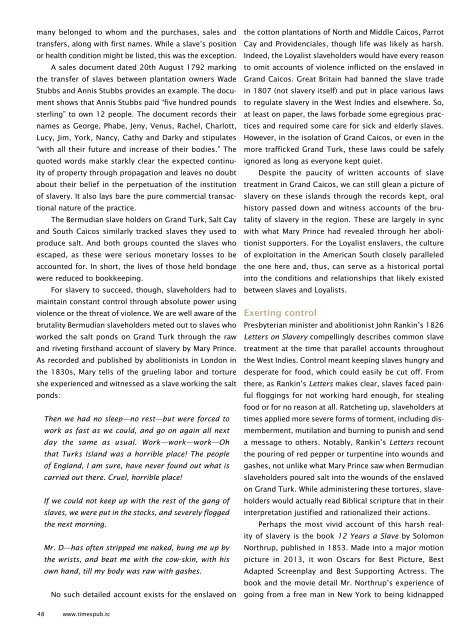Times of the Islands Spring 2020
Presents the "soul of the Turks & Caicos Islands" with in-depth features about local people, culture, history, environment, businesses, resorts, restaurants and activities.
Presents the "soul of the Turks & Caicos Islands" with in-depth features about local people, culture, history, environment, businesses, resorts, restaurants and activities.
Create successful ePaper yourself
Turn your PDF publications into a flip-book with our unique Google optimized e-Paper software.
many belonged to whom and <strong>the</strong> purchases, sales and<br />
transfers, along with first names. While a slave’s position<br />
or health condition might be listed, this was <strong>the</strong> exception.<br />
A sales document dated 20th August 1792 marking<br />
<strong>the</strong> transfer <strong>of</strong> slaves between plantation owners Wade<br />
Stubbs and Annis Stubbs provides an example. The document<br />
shows that Annis Stubbs paid “five hundred pounds<br />
sterling” to own 12 people. The document records <strong>the</strong>ir<br />
names as George, Phabe, Jeny, Venus, Rachel, Charlott,<br />
Lucy, Jim, York, Nancy, Cathy and Darky and stipulates<br />
“with all <strong>the</strong>ir future and increase <strong>of</strong> <strong>the</strong>ir bodies.” The<br />
quoted words make starkly clear <strong>the</strong> expected continuity<br />
<strong>of</strong> property through propagation and leaves no doubt<br />
about <strong>the</strong>ir belief in <strong>the</strong> perpetuation <strong>of</strong> <strong>the</strong> institution<br />
<strong>of</strong> slavery. It also lays bare <strong>the</strong> pure commercial transactional<br />
nature <strong>of</strong> <strong>the</strong> practice.<br />
The Bermudian slave holders on Grand Turk, Salt Cay<br />
and South Caicos similarly tracked slaves <strong>the</strong>y used to<br />
produce salt. And both groups counted <strong>the</strong> slaves who<br />
escaped, as <strong>the</strong>se were serious monetary losses to be<br />
accounted for. In short, <strong>the</strong> lives <strong>of</strong> those held bondage<br />
were reduced to bookkeeping.<br />
For slavery to succeed, though, slaveholders had to<br />
maintain constant control through absolute power using<br />
violence or <strong>the</strong> threat <strong>of</strong> violence. We are well aware <strong>of</strong> <strong>the</strong><br />
brutality Bermudian slaveholders meted out to slaves who<br />
worked <strong>the</strong> salt ponds on Grand Turk through <strong>the</strong> raw<br />
and riveting firsthand account <strong>of</strong> slavery by Mary Prince.<br />
As recorded and published by abolitionists in London in<br />
<strong>the</strong> 1830s, Mary tells <strong>of</strong> <strong>the</strong> grueling labor and torture<br />
she experienced and witnessed as a slave working <strong>the</strong> salt<br />
ponds:<br />
Then we had no sleep—no rest—but were forced to<br />
work as fast as we could, and go on again all next<br />
day <strong>the</strong> same as usual. Work—work—work—Oh<br />
that Turks Island was a horrible place! The people<br />
<strong>of</strong> England, I am sure, have never found out what is<br />
carried out <strong>the</strong>re. Cruel, horrible place!<br />
If we could not keep up with <strong>the</strong> rest <strong>of</strong> <strong>the</strong> gang <strong>of</strong><br />
slaves, we were put in <strong>the</strong> stocks, and severely flogged<br />
<strong>the</strong> next morning.<br />
Mr. D—has <strong>of</strong>ten stripped me naked, hung me up by<br />
<strong>the</strong> wrists, and beat me with <strong>the</strong> cow-skin, with his<br />
own hand, till my body was raw with gashes.<br />
No such detailed account exists for <strong>the</strong> enslaved on<br />
<strong>the</strong> cotton plantations <strong>of</strong> North and Middle Caicos, Parrot<br />
Cay and Providenciales, though life was likely as harsh.<br />
Indeed, <strong>the</strong> Loyalist slaveholders would have every reason<br />
to omit accounts <strong>of</strong> violence inflicted on <strong>the</strong> enslaved in<br />
Grand Caicos. Great Britain had banned <strong>the</strong> slave trade<br />
in 1807 (not slavery itself) and put in place various laws<br />
to regulate slavery in <strong>the</strong> West Indies and elsewhere. So,<br />
at least on paper, <strong>the</strong> laws forbade some egregious practices<br />
and required some care for sick and elderly slaves.<br />
However, in <strong>the</strong> isolation <strong>of</strong> Grand Caicos, or even in <strong>the</strong><br />
more trafficked Grand Turk, <strong>the</strong>se laws could be safely<br />
ignored as long as everyone kept quiet.<br />
Despite <strong>the</strong> paucity <strong>of</strong> written accounts <strong>of</strong> slave<br />
treatment in Grand Caicos, we can still glean a picture <strong>of</strong><br />
slavery on <strong>the</strong>se islands through <strong>the</strong> records kept, oral<br />
history passed down and witness accounts <strong>of</strong> <strong>the</strong> brutality<br />
<strong>of</strong> slavery in <strong>the</strong> region. These are largely in sync<br />
with what Mary Prince had revealed through her abolitionist<br />
supporters. For <strong>the</strong> Loyalist enslavers, <strong>the</strong> culture<br />
<strong>of</strong> exploitation in <strong>the</strong> American South closely paralleled<br />
<strong>the</strong> one here and, thus, can serve as a historical portal<br />
into <strong>the</strong> conditions and relationships that likely existed<br />
between slaves and Loyalists.<br />
Exerting control<br />
Presbyterian minister and abolitionist John Rankin’s 1826<br />
Letters on Slavery compellingly describes common slave<br />
treatment at <strong>the</strong> time that parallel accounts throughout<br />
<strong>the</strong> West Indies. Control meant keeping slaves hungry and<br />
desperate for food, which could easily be cut <strong>of</strong>f. From<br />
<strong>the</strong>re, as Rankin’s Letters makes clear, slaves faced painful<br />
floggings for not working hard enough, for stealing<br />
food or for no reason at all. Ratcheting up, slaveholders at<br />
times applied more severe forms <strong>of</strong> torment, including dismemberment,<br />
mutilation and burning to punish and send<br />
a message to o<strong>the</strong>rs. Notably, Rankin’s Letters recount<br />
<strong>the</strong> pouring <strong>of</strong> red pepper or turpentine into wounds and<br />
gashes, not unlike what Mary Prince saw when Bermudian<br />
slaveholders poured salt into <strong>the</strong> wounds <strong>of</strong> <strong>the</strong> enslaved<br />
on Grand Turk. While administering <strong>the</strong>se tortures, slaveholders<br />
would actually read Biblical scripture that in <strong>the</strong>ir<br />
interpretation justified and rationalized <strong>the</strong>ir actions.<br />
Perhaps <strong>the</strong> most vivid account <strong>of</strong> this harsh reality<br />
<strong>of</strong> slavery is <strong>the</strong> book 12 Years a Slave by Solomon<br />
Northrup, published in 1853. Made into a major motion<br />
picture in 2013, it won Oscars for Best Picture, Best<br />
Adapted Screenplay and Best Supporting Actress. The<br />
book and <strong>the</strong> movie detail Mr. Northrup’s experience <strong>of</strong><br />
going from a free man in New York to being kidnapped<br />
48 www.timespub.tc

















